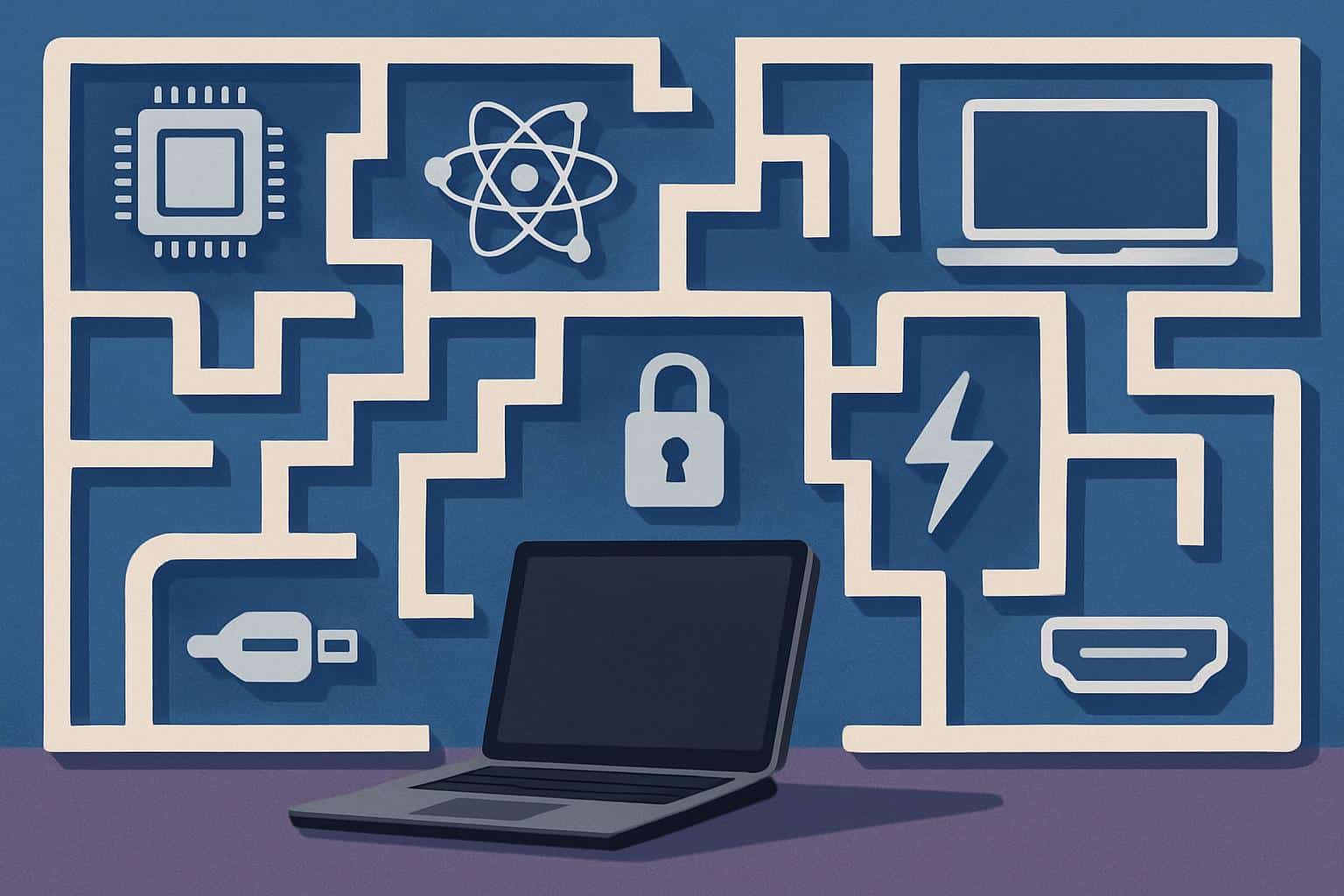When shopping for a laptop, you used to have to choose between looking and feeling good and being able to do the things you need it to do. Now it’s a labyrinth of chip varieties, AI capabilities, display technology, ports and platform lock-ins. The upshot is decision fatigue, even for those who closely track the market.
The stakes are higher, too. Prices have crept up, work and school loads are more demanding, and the wrong decision can lock you into a machine that fights against you for years. Here’s why buying is more complicated — and a clear framework for making the right decision for your needs.
- What the Laptop Market Got Wrong Over the Last Few Years
- The Specs That Actually Matter for Your Next Laptop
- Displays and Eyestrain Versus Speed: What to Know
- Battery Life Reality Check: Claims Versus Real Use
- Ports, Connectivity, and Upgradability: What to Look For
- Software, Security, and Support Across Platforms
- Price, Value, and Sustainability: Balancing Priorities
- A Basic Rubric for Deciding on Your Next Laptop

What the Laptop Market Got Wrong Over the Last Few Years
Three shifts rammed together: new silicon, new screens and new connectors. Apple switched the Mac to its own chips, Windows laptops followed suit with hybrid designs that used low‑power cores and had embedded NPUs for on‑device AI. AMD and Intel sell TOPS and “AI PCs” that don’t translate well into the way humans understand performance in daily life. IDC and Gartner analysts both mention a proliferation of SKUs as brands race toward niches, leading to more choice — and more confusion.
Displays went from simple 60Hz panels to OLED, mini‑LED and high‑refresh LCDs. Connectivity has jumped from USB‑A to USB‑C with USB4 or Thunderbolt, Wi‑Fi 6E and now Wi‑Fi 7. Labels tend to sound the same yet act very differently in practice, resulting in mismatched expectations.
The Specs That Actually Matter for Your Next Laptop
Start with workload, not marketing. For office tasks, coding and light work with content of any kind, you want modern CPUs with good sustainable performance and efficiency. The integrated graphics of Intel Core Ultra and AMD Ryzen 7000/8000 series are respectable; battery life is excellent in Apple’s M‑series, and performance doesn’t have any real surprises. That, or a midrange Nvidia RTX 4060 at minimum in something with sensible thermals, is the genuine upgrade if your apps involve GPU acceleration (video editing, 3D models, AI models).
Memory and storage are the quiet holdups. Consider 16GB RAM as a bare minimum; for heavy multitasking, big data or creative suites, go with 32GB. Shoot for at least a 512GB SSD to limit the juggle most of the time. Seek models with at least one open M.2 slot; soldered storage keeps you locked out.
Displays and Eyestrain Versus Speed: What to Know
Higher resolution isn’t always better. A crisp 14‑inch 120Hz 1440p panel can feel snappier and more comfortable than a 4K 60Hz display, especially when it comes to scrolling and editing timelines. You should look for wide‑gamut accuracy (near‑100% sRGB and large DCI‑P3 coverage), plus a reliable factory profile; certifications such as DisplayHDR are useful but not proof of color precision.
With OLED come the deepest blacks and best contrast, but be aware of brightness and dimming performance. (Notebookcheck’s independent tests tend to pick up on aggressively PWM‑dimmed panels, known for causing eyestrain in some users.) If you’re susceptible, look out for displays that feature high PWM frequencies or DC‑dimming modes.
Battery Life Reality Check: Claims Versus Real Use
Manufacturer claims are optimistic. Independent tests from sources such as RTINGS and Notebookcheck often end up 20% to 40% lower in mixed use than vendor numbers. A greater battery capacity (in watt‑hours) and an energy‑efficient platform are better indicators than marketing copy. Integrated graphics, adaptive‑refresh displays and ARM‑based chips tend to be light on power; dGPUs and 4K panels are not.
Also verify charging. USB‑C Power Delivery is nice, but some performance laptops do throttle on 65W travel bricks. If you need a proprietary 200W adapter to hit full speed — well, that impacts the laptop’s portability more than its spec sheet would lead us to believe.

Ports, Connectivity, and Upgradability: What to Look For
USB‑C labels are murky. Both USB4 and Thunderbolt 4 deliver 40 Gbps, but that doesn’t mean every port on a laptop will support full bandwidth, external GPU enclosures or dual 4K displays. Read the fine print, and opt for at least two high‑speed USB‑C ports on opposite sides. Creators will continue to appreciate full‑size SD card readers, and gamers and presenters will appreciate HDMI 2.1.
Inside, try to get at least one user‑replaceable M.2 drive and perhaps socketed RAM (SODIMM) instead of soldered‑on LPDDR. iFixit repairability scores and the burgeoning Right to Repair movement testify to how serviceable designs reduce e‑waste and total cost of ownership. Modular systems such as Framework show us the possibilities of what good access across components can look like.
Software, Security, and Support Across Platforms
Your apps should dictate which platform you choose. macOS is great for creative apps and battery life, Windows has the widest range of software and gaming support, ChromeOS is good for web‑first workflows and managed fleets. And if you’re dependent on virtual machines or esoteric peripherals, Windows almost always provides the best compatibility.
Security and updates vary. Search for hardware roots of trust (TPM 2.0 or Microsoft Pluton on Windows, Secure Enclave on Macs), physical webcam shutters and biometric logins. Business‑class lines often give you more extended firmware support and next‑business‑day service options than consumer models — which count over a four‑ to five‑year ownership window, as IDC cited.
Price, Value, and Sustainability: Balancing Priorities
What you own brings sticker‑price pain. A somewhat more expensive model that comes with a three‑year warranty, on‑site repair and parts availability may be less costly than a suspiciously cheap machine that fails early. Environmental certifications such as EPEAT and Energy Star indicate improved efficiency or materials practices and can fit into corporate purchasing policies.
Refurbished can be a savvy move if the manufacturer or a trusted reseller offers a fresh battery and warranty. Gartner observes that companies are normalizing refresh cycles, and a strong resale market for popular models can help mitigate an upfront investment.
A Basic Rubric for Deciding on Your Next Laptop
Write up your top three tasks and the software you need to be on. Define the weight and minimum battery. Choose platform first, lock in specs after: 16GB/512GB for general use, including web development or light media work; 32GB/1TB and a medium‑power GPU for creative pros or ML‑capable workloads. Create a shortlist of three models that clear those bars, and then look up independent tests for each model’s thermal, display and battery performance from several different outlets. If you can, test out the keyboard and trackpad in person, and check that return window.
Quick examples: a student who lives in docs and browsers should look for a light 13‑ or 14‑inch laptop that has great battery life, 16GB of system RAM and Wi‑Fi 6E or better. If you’re a remote worker who lives on video calls, look for a 1080p or 5MP webcam, dual mics and at least two fast USB‑C ports. If you’re a creator or gamer, the most important things for you are a well‑cooled chassis, a 120Hz (or faster) screen, 32GB of RAM and an RTX‑class GPU.
Along with choosing a new car, purchasing a laptop is one of the most end‑of‑autumn things you can do — and also something that’s more confusing to shoppers in 2020 than ever before. But clarity on your workload, patience for the ecosystem or product platform, and a few non‑negotiable specs will help steer the way through all that confusion. Use the independent data, support upgradability and support, and you’ll decide once and choose well.

